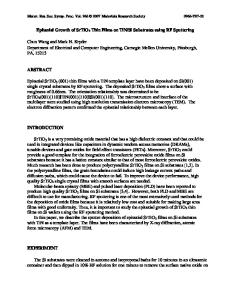Epitaxial growth of PbTiO 3 thin films on (001) SrTiO 3 from solution precursors
- PDF / 7,047,790 Bytes
- 12 Pages / 584 x 793 pts Page_size
- 31 Downloads / 418 Views
A mixed alkoxide liquid precursor was used to form epitaxial PbTiO3 thin films by spin-coating on cubic (001) SrTiO3 substrates. The films were heat-treated at temperatures between 380 °C/1 h and 800 °C/1 h. X-ray diffraction, atomic force microscopy, scanning and transmission electron microscopy were used to characterize the microstructure of the films and to evaluate the epitaxial phenomena. At ~400 °C/1 h, a polycrystalline, metastable Pb-Ti fluorite crystallizes from the pyrolyzed amorphous precursor. At slightly higher temperatures (~420 °C/1 h), the thermodynamically stable phase with the perovskite structure epitaxially nucleates at the film/substrate interface. A small number of epitaxial grains grow through the film toward the surface and consume the nanocrystalline fluorite grains. Coarsening of the perovskite grains leads to a reduction in mosaic spread during further heating. Pores, which concurrently coarsen with grain growth, produce a pitted surface as they disappear from within the film. At 800 °C/1 h a dense epitaxial PbTiO3 film with a smooth surface is observed. Parameters governing the formation of a- and c-domains are discussed as well as the small tilts of the domain axes away from the substrate normal.
I. INTRODUCTION Single crystal ferroelectric thin films are preferred to polycrystalline films for a range of optical and electronic applications in order to take full advantage of their anisotropic properties.1-2 For example, the pyroelectric properties of PbTiO3 are optimal along the (001) polar direction; thus single crystal films are preferred for pyroelectric devices.3 Further, devices that use optical transmission require films that do not contain grain boundaries that scatter light. A number of techniques have been employed to grow either oriented or epitaxial thin films of ferroelectric lead titanate, lead titanate zirconate (PZT), and lanthanum modified PZT (PLZT) on single crystal substrates including MgO,3"5-13 SrTiO3,6'12 MgAl 2 O 4 /Si, u YBa2Cu 3 0 7 /LaA10 3 , 9 (La,Sr)CoO 3 /SrTiO 3 , 8 (La,Sr)CoO 3 / MgO, 8 (La,Sr)CoO 3 /Zr(Y)O 2 /Si, 10 Pt/MgO,2-5 as well as Pt/Ti/SiO 2 /Si. 5 ' 7 Deposition methods include radio frequency sputtering,3"7 pulsed laser deposition,8"10 and chemical vapor deposition.11"13 A small number of groups have been processing thin films by solution chemistry routes. In these methods, a precursor solution14'15 containing metal-organic molecules in either an aqueous or organic solvent is used to form a solid precursor film on a substrate by either spin-coating16 or dip-coating.17 During coating the solvent evaporates to produce a solid, amorphous precursor film. The precursor film decomposes (pyrolyzes) and crystallizes during heating at low temperature to form a partially dense, polycrystalline thin film of the desired inorganic composition. 680
http://journals.cambridge.org
J. Mater. Res., Vol. 10, No. 3, Mar 1995
Downloaded: 11 Mar 2015
The mechanisms leading to epitaxy in precursor derived films are different from phenomena associated with vapor pha
Data Loading...










